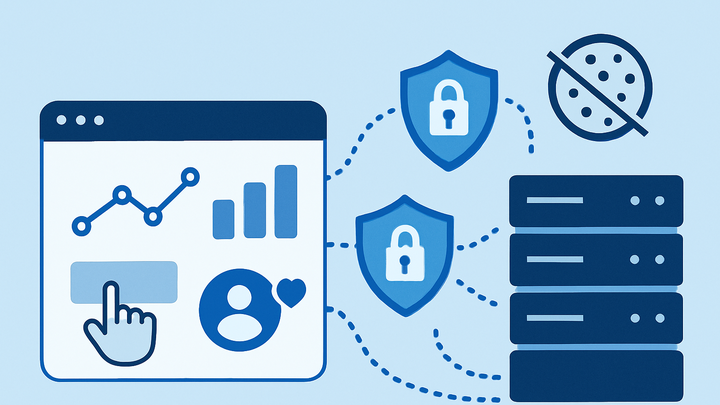Published on 2025-06-28T04:39:00Z
What is Cookie-Free Tracking? Examples for Cookie-Free Tracking
Cookie-Free Tracking is a web analytics approach that collects and analyzes user behavior data without relying on browser cookies. As privacy regulations (GDPR, CCPA) tighten and major browsers phase out third-party cookies, traditional cookie-based analytics face growing limitations. Cookieless techniques leverage server-side event collection, first-party identifiers, and advanced modeling to maintain accurate insights while preserving user privacy. This method ensures compliance with consent requirements, reduces data loss from ad blockers, and future-proofs analytics against the deprecation of cookies. Leading tools like PlainSignal specialize in lightweight, privacy-first tracking scripts. Google Analytics 4 also incorporates predictive modeling and first-party data to fill gaps caused by cookie restrictions, offering a hybrid approach to modern analytics.
Cookie-free tracking
Cookieless tracking collects analytics without browser cookies, using server-side events, first-party identifiers, and modeling to ensure privacy and accuracy.
Why Cookie-Free Tracking Matters
In an era of increasing privacy regulations and cookie deprecation, cookieless analytics has become essential for reliable insights. This section explores the key factors driving the shift away from traditional cookie-based tracking.
-
Privacy regulations
Laws like GDPR and CCPA impose strict consent and data usage rules, making third-party cookies non-compliant without explicit user permission.
-
Gdpr
Defines stringent requirements for user consent, data minimization, and the right to be forgotten within the European Union.
-
Ccpa
Grants California residents control over their personal data, including the ability to opt out of data sales and request deletion.
-
-
Browser restrictions
Modern browsers block or phase out third-party cookies by default, reducing the effectiveness of traditional analytics setups.
-
Third-party cookie blocking
Safari’s Intelligent Tracking Prevention (ITP) and Firefox’s Enhanced Tracking Protection (ETP) automatically delete or block cookies.
-
Future deprecations
Google Chrome plans to phase out third-party cookies, impacting analytics and advertising platforms that rely on them.
-
How Cookie-Free Tracking Works
Cookie-free tracking combines server-side processing, first-party identifiers, and statistical modeling to capture user interactions without setting browser cookies.
-
Server-side event processing
User interactions are sent directly from the browser to a secure server endpoint, bypassing the need for client-side cookie storage.
-
Direct http calls
Leverages fetch or XHR requests to post event data to analytics servers.
-
Data aggregation
Servers aggregate and anonymize event data before analysis, ensuring user privacy.
-
-
First-party identifiers
Uses non-cookie identifiers like local storage tokens or hashed IDs to recognize returning users without PII.
-
Local storage tokens
Stores a unique identifier in local storage to track sessions across visits.
-
Anonymous identifiers
Generates hashed or randomized IDs that do not reveal personal information.
-
Benefits of Cookie-Free Tracking
Adopting cookieless analytics delivers stronger privacy protections and more consistent data in a landscape of growing cookie restrictions.
-
Enhanced user privacy
Eliminating cookies reduces the risk of cross-site tracking and misuse of personal data.
-
Anonymized data
Sensitive user details are removed or hashed before storage, safeguarding identity.
-
No third-party sharing
Data remains within first-party servers, preventing external vendors from tracking users.
-
-
Reliable analytics data
Server-side methods are less affected by ad blockers and browser cookie policies, ensuring a complete dataset.
-
Ad-blocker resilience
Since events are sent server-side, they bypass client-side blocking tools.
-
Cross-device continuity
Servers can stitch sessions across devices using first-party identifiers.
-
Implementation Examples
Practical code snippets and configuration tips for setting up cookieless tracking with popular analytics platforms.
-
PlainSignal cookie-free setup
PlainSignal provides a lightweight, cookieless analytics script that is ready to deploy. To install:
-
Embed script
<link rel="preconnect" href="//eu.plainsignal.com/" crossorigin /> <script defer data-do="yourwebsitedomain.com" data-id="0GQV1xmtzQQ" data-api="//eu.plainsignal.com" src="//cdn.plainsignal.com/plainsignal-min.js"></script> -
Verify data
Check the PlainSignal dashboard to confirm that pageviews and events are being recorded correctly.
-
-
Google analytics 4 configuration
GA4 can be configured for reduced cookie usage and cookieless data modeling. Basic gtag setup:
-
Basic setup
<script async src="https://www.googletagmanager.com/gtag/js?id=G-XXXXXXX"></script> <script> window.dataLayer = window.dataLayer || []; function gtag(){dataLayer.push(arguments);} gtag('js', new Date()); gtag('config', 'G-XXXXXXX', { 'storage': 'none', 'anonymize_ip': true }); </script> -
Enable modeling
In the GA4 interface, go to Admin > Data Settings > Data Collection, and enable cookieless measurement modeling to fill in gaps.
-
